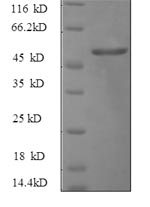Recombinant rat hepatocyte growth factor (HGF) is a high-purity protein with purity levels greater than 90%, as verified by SDS-PAGE. This protein, derived from rat species and expressed in E. coli, includes the partial expression region 477-728aa. It features an N-terminal GST-tag for ease of purification and detection. It is available in both liquid and lyophilized powder forms.
Rat HGF is a crucial cytokine involved in liver regeneration and hepatocyte proliferation. HGF is produced by non-parenchymal cells in the liver, such as Kupffer cells and hepatic stellate cells, and its expression is significantly upregulated during liver regeneration, particularly following partial hepatectomy [1]. When stimulated by c-Met, HGF activates multiple downstream signaling cascades, including the PI3K/Akt and MAPK pathways, essential for hepatocyte proliferation and survival [2][3].
In vitro studies have demonstrated that HGF promotes hepatocyte proliferation and enhances their survival by exerting anti-apoptotic effects [4]. HGF also influences the differentiation of stem cells into hepatocyte lineages, indicating its pivotal role in liver development and repair processes [5].
References:
[1] M. Li, X. Zhou, J. Mei, X. Geng, Y. Zhou, W. Zhang, et al., Study on the activity of the signaling pathways regulating hepatocytes from g0 phase into g1 phase during rat liver regeneration, Cellular & Molecular Biology Letters, vol. 19, no. 2, 2014. https://doi.org/10.2478/s11658-014-0188-2
[2] A. Coutant, C. Rescan, D. Gilot, P. Loyer, C. Guguen‐Guillouzo, & G. Baffet, Pi3k-frap/mtor pathway is critical for hepatocyte proliferation whereas mek/erk supports both proliferation and survival, Hepatology, vol. 36, no. 5, p. 1079-1088, 2002. https://doi.org/10.1053/jhep.2002.36160
[3] H. Moteki, M. Kimura, & M. Ogihara, Activation of extracellular-signal regulated kinase by epidermal growth factor is potentiated by camp-elevating agents in primary cultures of adult rat hepatocytes, Biological and Pharmaceutical Bulletin, vol. 34, no. 10, p. 1542-1552, 2011. https://doi.org/10.1248/bpb.34.1542
[4] Z. Li, S. Mizuno, & T. Nakamura, Antinecrotic and antiapoptotic effects of hepatocyte growth factor on cholestatic hepatitis in a mouse model of bile-obstructive diseases, Ajp Gastrointestinal and Liver Physiology, vol. 292, no. 2, p. G639-G646, 2007. https://doi.org/10.1152/ajpgi.00292.2006
[5] S. Oh, M. Miyazaki, H. Kouchi, Y. Inoue, M. Sakaguchi, T. Tsujiet al., Hepatocyte growth factor induces differentiation of adult rat bone marrow cells into a hepatocyte lineage in vitro, Biochemical and Biophysical Research Communications, vol. 279, no. 2, p. 500-504, 2000. https://doi.org/10.1006/bbrc.2000.3985








